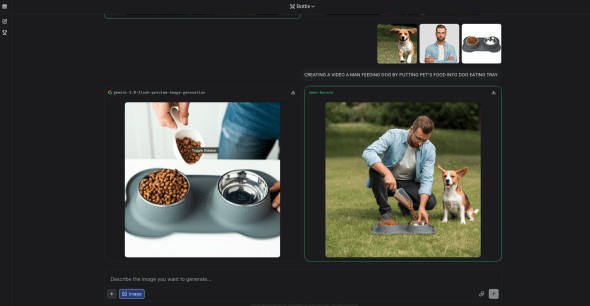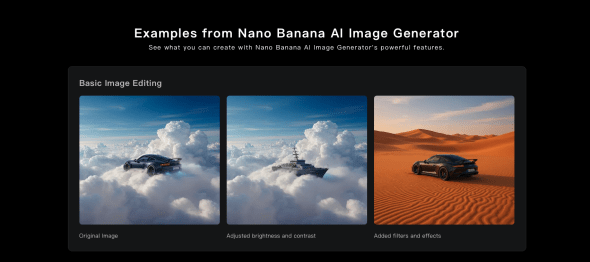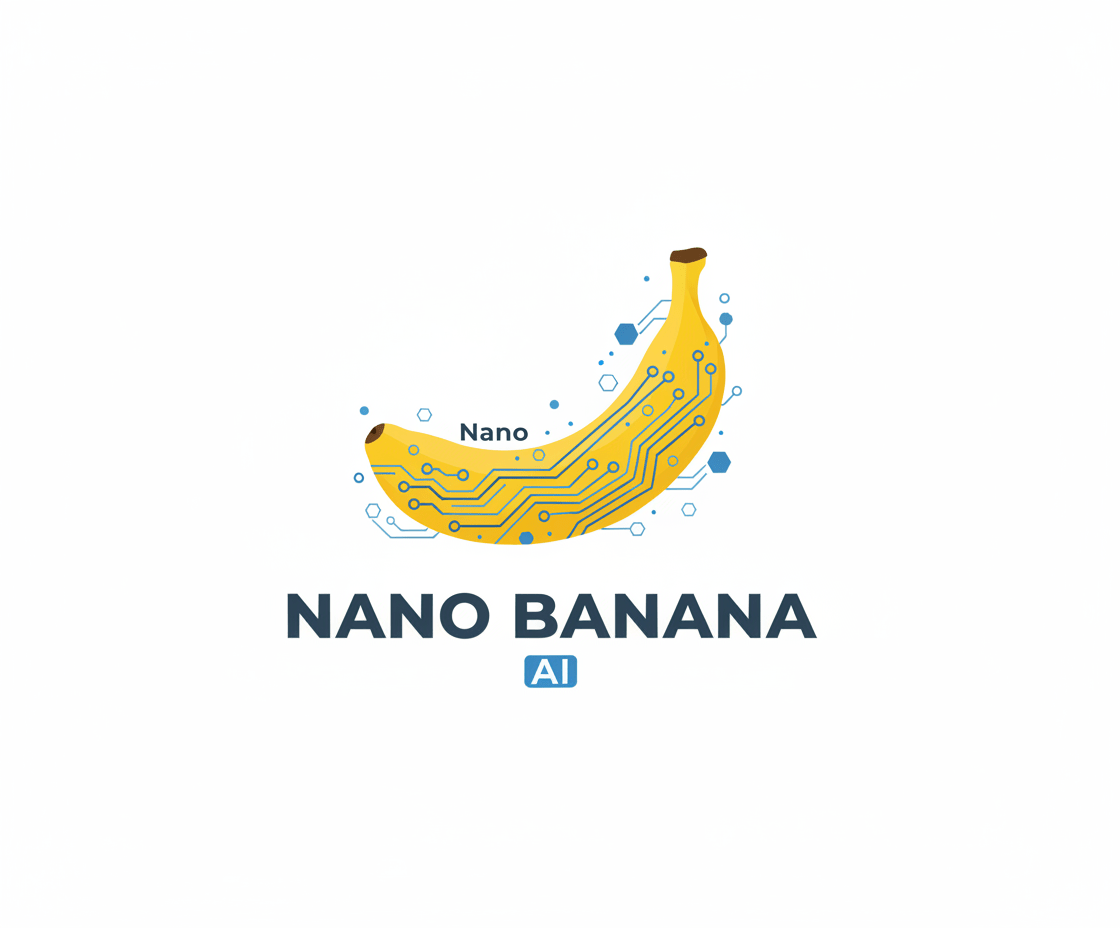Nano Banana – The Ultimate AI Image Editor
Nano Banana is an application that lets users edit image with AI and generate new ones from text commands. It is powered by Google’s Gemini 2.5 Flash image model and the tool became known in August 2025, after a quiet release.
Nano Banana is useful for people who need quality visuals but do not have professional design skills. It is built for a wide audience, including social media creators, small business owners, photographers, and marketing professionals.
Nano Banana’s main function is to simplify photo editing. It presents an alternative to traditional workflows that require software like Adobe Photoshop. Instead of using manual tools for selections and adjustments, users can perform detailed edits—like changing a background or modifying clothing—by typing a direct command. This approach makes advanced image modification accessible to more people, offering a faster way to produce visual content.
Best Use Cases of Nano Banana
- E-commerce and Product Marketers: For online retailers, creating a large volume of high-quality, consistent product photos is a constant challenge. Nano Banana addresses this by allowing users to instantly change backgrounds, add props, or adjust lighting across an entire product line with a few text prompts. For example, a marketer could take a standard photo of a shoe and command the program to “place this shoe on a beach at sunset” or “change the color of the laces to red,” producing fitting mockups in seconds and greatly reducing photography costs.
- Marketing and Advertising Professionals: Ad campaigns often require numerous visual assets featuring the same character or product in different scenarios. Nano Banana excels at maintaining character and object consistency, a common failing of other AI models. A marketing team can create a mascot and then produce dozens of images of that exact mascot performing different actions, ensuring perfect brand continuity across all campaign materials.
- Content Creators and Social Media Managers: These users need a constant stream of unique, eye-catching visuals to keep their audience engaged. This tool allows for rapid creative iteration. A blogger could take a photo and ask the tool to “turn this into a watercolor painting” or “add a steampunk hat to my cat.” The ability to ai edit image assets so quickly transforms ordinary pictures into compelling content that stands out on social media feeds.
- Concept Artists and Designers: In the early stages of design for games, films, or products, speed and iteration are key. Nano Banana acts as a powerful brainstorming partner. A concept artist can upload a rough sketch of a character and use text prompts to rapidly explore variations, such as “give this character futuristic armor” or “change the setting to a post-apocalyptic city,” visualizing ideas almost as fast as they can type them.
Text-Based Command Editing: The ability to perform edits using simple text makes the tool approachable for users of any skill level.
High-Quality, Photorealistic Output: Nano Banana produces detailed, high-resolution images that often look like real photographs.
Strong Character Consistency: The tool does a good job of maintaining a person's facial features and appearance across multiple images and edits.
Precise Localized Editing: Users can apply changes to specific parts of an image, such as a single item of clothing, without altering the rest of the picture.
Fast Processing Speed: Edits and image generations are typically finished in 15-30 seconds, much faster than manual methods.
Currently Free to Use: The tool is available at no cost, removing financial barriers to accessing its image editing functions.
Versatile Feature Set: The application includes a wide range of functions, from text-to-image creation to in-painting and style transfers
Occasional Facial Distortions: The AI can sometimes generate faces that appear unnatural, particularly when making large changes to a portrait.
Text Rendering Difficulties: The tool may struggle with correct text spacing and formatting when adding or replacing words within an image.
Data Privacy Considerations: Because it is a Google product, uploaded images may be stored on Google's servers, which could be a concern for users with sensitive material.
Lack of Manual Controls: The tool does not provide the detailed, layer-based control that professionals get from software like Adobe Photoshop.
-
Text-to-Image Generation: Creates images from scratch based on a user’s textual description.
-
Local Image Editing: Allows users to select a specific area of an image and modify it with a text prompt.
-
Character-Locking Consistency: A standout function that keeps a character’s appearance identical across multiple generated scenes.
-
Style Transfer: Applies various artistic styles (e.g., oil painting, sketch, anime) to an existing image.
-
Background Removal and Replacement: Instantly removes the background from a photo and can replace it based on a text description.
-
Object Addition and Removal: Adds new objects to an image or erases unwanted ones, intelligently filling in the background.
-
Prompt Adherence Engine: The underlying technology that allows the tool to understand and execute complex, multi-part prompts with high fidelity.
-
Web-Based Interface: Accessible through a web browser without the need for any software installation.
 Image Edited By Nano Banana
Image Edited By Nano Banana
 Nano Banana Gallery
Nano Banana Gallery
Frequently Asked Questions
- What is Nano Banana?
Nano Banana is an AI tool from Google that generates and edits images using text commands. - Who is Nano Banana for?
The tool is for a general audience, including social media creators, marketers, business owners, and anyone who needs to make visuals quickly. - How much does Nano Banana cost?
Nano Banana is currently free. - How do I use Nano Banana to edit image with ai?
You can edit image with ai by uploading your photo and typing a command that describes the specific change you want to make. - What is the technology behind Nano Banana?
The tool is thought to be an application of Google’s Gemini 2.5 Flash image model, a part of their generative AI research.
Tech Pilot’s Verdict On Nano Banana
I’ve been tracking the buzz around Nano Banana for a while, and it’s one of those rare programs that feels like a genuine step-change in technology. This tool finds it to be a highly functional and accessible tool for image editing and generation. Its performance was evaluated based on its core features and user-reported outcomes in common scenarios.
First, I focused on its most lauded feature: consistent, prompt-based editing. I tried a test by uploading 3 photos of a man, a dog and a dog food tray then issued the prompt, “A man feeding his dog by putting pet’s food into the dog food tray” Most AI editors would struggle with this, often altering the man’s face or producing the man’s posture that looks strange. The results from Nano Banana were noteworthy. The man’s posture was adjusted naturally to fit the feeding action, the dog’s expression looked attentive and lifelike, and the tray appeared perfectly aligned in the scene. This is more than image generation; it’s image understanding.
Next, I examined its character consistency. This is a critical need for marketers and storytellers. I watched a user generate an image of a unique cartoon fox. They then used that same fox as a reference in a new prompt: “The same fox drinking coffee in a cafe.” The output was perfect. It wasn’t just a similar fox; it was the exact same character, down to the specific markings on its fur. This capability alone puts it ahead of many competitors for any project requiring narrative continuity.
However, the application has limitations. When tasked with adding complex text to an image, such as a business name on a sign, the results can be inconsistent in terms of letter spacing and alignment. Additionally, while its photorealism is strong, some generated human faces can have subtle, unnatural-looking features.
Top Alternatives to Nano Banana
-
OpenAI’s DALL-E 3: DALL-E 3 is a creative tool for generating images from scratch. Integrated into ChatGPT, it excels at interpreting nuanced, conversational prompts to produce highly imaginative visuals. While Nano Banana is a scalpel for precise image manipulation, DALL-E 3 is a broad, versatile brush for creation. If your primary need is generating diverse, original images and you prefer creative brainstorming, DALL-E 3 is likely the better choice. Its ability to edit image with ai is less refined and consistent than Nano Banana’s.
-
Midjourney: Midjourney is the leader for artistic and aesthetically stylized imagery. It produces beautiful, high-impact visuals that often look like digital paintings. Its community-driven platform on Discord and unique prompting style are geared toward artists and designers. Midjourney is the best option for creating fine art, fantasy concepts, and visually striking graphics. It falls short when compared to Nano Banana for photorealistic editing and maintaining strict character consistency, prioritizing artistic flair over precise alteration.
-
Flux AI Models (Flux.1 / Kontext): The Flux AI platform itself offers a suite of capable models that are direct competitors. These models are more readily accessible and provide a fantastic balance of generation and editing capabilities. They are open-weight, making them attractive to developers and researchers. While highly capable, side-by-side comparisons show that Nano Banana currently has a performance edge, particularly in its almost magical ability to follow complex editing commands and lock character consistency. For users who need a reliable, high-quality program from the same platform, the other Flux models are a top-tier choice.
Final Verdict
Nano Banana is a valuable tool for a large group of users. It is not a replacement for professional software like Photoshop, but it offers a much faster and more accessible way to handle many common image editing tasks. For marketers, creators, and small businesses, it is a highly effective utility that can greatly speed up the production of visual content. Its current flaws are minor compared to its overall utility and ease of use.

